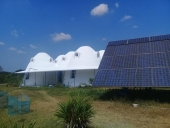


James Marquardt wrote: My thought is to parallel some smaller pocket plate Nifes I have up to 240 or 320Ah and use that as a replacement cell in the big string but I don't know how it would affect the others or if the replacement might pop!

Greg Payton wrote:Hey Mark Cunningham, wood gasifiers have always been interesting to me, but I haven't been sure how to maximize them. One thing I have always wanted to see is a wood gasifier setup that does THREE things in a unified setup - is this possible???
1. Cooking
2. Boiling water to turn a turbine and produce electricity
3. Collect the water back out for use in a home and and farm (and even use it for defrosting solar panels and passive blacktop roof water heaters and other things during the winter)
(BONUS: 4. Recycle unused water back into the system to reduce waste & probably need a way to clean out hardwater deposits)
This wood gasifier usage might be the best use for this wood if there's some effective ways to use this as such!

Greg Payton wrote:I was hoping to get some ideas of what one might use these for?
Walter Racka wrote:Thanks All for the info. I'm not ready to commit to all the work that appears necessary to buy and bring these batteries back to life. Would love to do it but...I'm a newbie to all this and just want to get my feet wet not get in over my head. Thanks again, Walt
Walter Racka wrote: I am trying to find out more about the Edison 240 batteries as I have an opportunity to buy 20 of them.

Phil Stevens wrote:two masterful replies
Phil Stevens wrote:the arc you want is different and creates a fine slicing movement.

r ranson wrote:
Either the end of my stroke the tip goes up - most common Or if I keep the tip down, the start of my stroke is up.
r ranson wrote:
Or if I can somehow get both start and stop of the stroke to stay at the right level, the middle bit didn't cut. It just bent. I also seem to be having a problem with keeping the blade low enough to the ground. Most of my cuts are at ankle height.
r ranson wrote:
There is a lot of grass laying over on its side. This is the mid-height stuff, just about ankle height.
r ranson wrote:
Two things I want to look up before the next scything session
1. my back feels hunched up, it seemed to get into a very rounded posture and I feel I could scythe longer if I could keep it upright.
2. can I adjust the snathe on this somehow to make it match my height better?

Sarah Tennant wrote:What if I used an earthen plaster on the interior walls, so the earthbags could breathe that way?
Sarah Tennant wrote:I've seen a method of earthbag construction where the earthen plaster is applied at the same time as the earthbags are laid
Sarah Tennant wrote:thermal mass of earthbags, but am worried about their lack of insulative properties.
Sarah Tennant wrote:then cover that ... in plaster/stucco, possible with a stone facade for the bottom few feet
Paul Canosa wrote:I think the challenge to financial independence is from fiat currency

Tomas Marhold wrote:
Hello Mark, Thanks for all of the information. I think you know a lot about electricity and solar. Yesterday I put one panel in the sun and hooked up the multi meter. 22.4 volts and around 2.4 - 3.04 Amps. But the Amps kept fluctuating. Upon further inspection the silver ribbons in the panels look damaged at the intersections. I attached a photo. Surprisingly, one panel is working but damaged. I switched my batteries back to 12v and using the one panel to charge them but it's not working so good. I got a battery charger today and using it now to keep the batteries fresh. But they sat at 12.4 for a weeks. I will check out your function test on YouTube. I ordered a soldering iron from Shopee but it didn't arrive yet. I borrowed one from my friend but it has no power it's useless.
I'm in Nueva Ecija, Palayan city, Luzon. Small Town.
Thanks. Ignat. T---